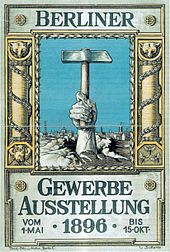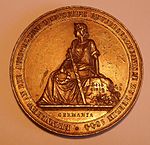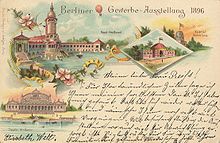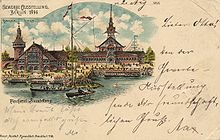Berlin trade exhibition
The first trade exhibitions in Berlin took place in the first half of the 19th century. The most famous and largest took place in 1896 just outside Berlin in the rural community of Treptow in Treptower Park and is also referred to as the "prevented world exhibition ". The Archenhold observatory remains from the show .
First exhibitions in the greater Berlin area
Commercial exhibitions in 1822 and 1827
Initiated by the Prussian statesman Christian Peter Wilhelm Beuth , who was a great promoter of the trade, the first regional exhibition took place in the trade building on Klosterstrasse from September 1 to October 15, 1822 . At that time, 182 traders presented 998 different products to the 9514 visitors. Another exposition followed in 1827 at the same location.
General German Trade Exhibition 1844
In 1844 the General German Trade Exhibition took place in the armory on Unter den Linden . 685 Berlin entrepreneurs were among the 3,040 exhibitors. 260,000 visitors were counted at this exhibition of German commercial products.
Berlin trade exhibition 1879
The Berlin trade exhibition of 1879 took place on the ULAP site at Lehrter Bahnhof . It was an exhibition of technical innovations with supraregional importance and also offered visitors an adventure park.
The highlight and crowd puller of the exhibition was the first electrically operated railway from Siemens & Halske . Werner Siemens (not yet ennobled at the time) personally presented his development on May 31. No less than 90,000 people drove the 300-meter route during the four-month exhibition .
The technical sensation was later demonstrated in Brussels , Frankfurt am Main during the General Patent and Design Protection Exhibition (1881) in the Palmengarten in Frankfurt , Copenhagen , London and Moscow . The original locomotive that has been preserved is now in the Deutsches Museum in Munich , a copy is on display in the Berlin Museum of Technology .
Berlin trade exhibition in Treptow in 1896
prehistory

After the successful world exhibitions in London and Paris , the capital of Berlin was also urged to host its own world exhibition. In particular the "Association of Berlin Merchants and Industrialists" (which incidentally still exists) under its chairman Max Ludwig Goldberger (1848–1913), which was founded for the trade exhibition in 1879, made this a life's work (Goldberger, which can be described as "dynamic" from contemporary reports, lived in the USA for a year and wrote, among other things, the book Land of Unlimited Possibilities , the title of which has now become proverbial) - he was aware of the advantages on an international level. At the end of the 19th century Berlin developed rapidly into the leading industrial metropolis of Europe, so that one did not want to lag behind Paris in self-confidence - at the latest with the erection of the Eiffel Tower for the World Exhibition in 1889 , the bourgeois press in Berlin ceaselessly used the word that it was the " hereditary enemy " to show again.
Despite intensive efforts, the chambers of commerce repeatedly refused and, due to the precarious financial situation of the empire, Kaiser Wilhelm II and his chancellor Leo von Caprivi ultimately rejected the project. Although the Kaiser liked to present himself in public, he was strongly averse to the project - on July 20, 1892 he wrote to his Chancellor:
“The fame of the Parisians does not let the Berliner sleep. Berlin is a big city, so it has to have an exhibition too. This is totally wrong. Paris is what Berlin hopefully never will be, the great whore house in the world. "
And on many occasions when the topic came up, he would say briefly, “The exhibition isn’t, as my gentlemen from Berlin say”, referring to the Berlin dialect .
In a kind of defiant reaction, the Association of Berlin Merchants and Industrialists (VBKI) and a specially founded interest group took over the initiative - although they no longer called the exhibition that was to be organized under their own direction, the world exhibition, the rather provincial name “industrial exhibition” must in no way exceed the envisaged dimensions hide it - an intended fraudulent label. A date was also quickly found - it was to take place for the 25th anniversary of Berlin as the Reich capital. Construction work began in the spring of 1894 - it was to be a German exhibition to strengthen the local economy. Germany was regarded as a high-tech country and Berlin as the center of science, industry and services.
exhibition
After all, the exhibition took place as a Berlin trade exhibition from May 1 to October 15, 1896 in Treptower Park . The area of 900,000 m² was even larger than the previous world exhibitions. Around the Neuer See , an artificially created water basin with an area of 10,000 m² (later the Soviet Memorial was created here), the pavilions of the 3780 exhibitors, which were divided into 23 groups, were grouped on the extensive area along the Spree . The largest building was the main industrial building near the main entrance, where 13 groups were housed to present their products and developments. The buildings directly on the New Lake with observation towers, restaurant, foyer and gondola harbor were designed by Bruno Schmitz .
During the preparations for the trade exhibition in 1896, numerous structural changes and improvements were made in the rural community of Treptow. In order to bring the expected number of visitors (around seven million) from the city center to Treptow, the traffic routes had to be expanded. Many roads were newly laid out or paved, and local public transport was significantly expanded. The Görlitzer Bahn received its own station exhibition , which was closed again after the exhibition. Several electric tram lines of the Great Berlin Horse Railway and the electric trams operated by Siemens & Halske in Berlin went into operation in April. And the Ringbahn also had its own stop - today's Treptower Park S-Bahn station . An entrance to the exhibition led across the Spree - even jetties for their majesties had been set up. On the Spree, a closely-timed regular service of motor boats and steamers from various shipping companies was planned, but its implementation is questionable and was discontinued by at least one provider during the exhibition, although this means of transport managed naturally without expanding the traffic routes. The utilization of the ships actually in operation, including the two newest star steamers , remained unsatisfactory. Access to the exhibition under the Spree was also planned - the Spreetunnel Stralau – Treptow was intended to be a demonstration object for underground railways in Berlin , but was not put into operation until 1899 by the Berlin Ostbahnen .
Within the exhibition, visitors were able to use the Naglo electrical circuit , which led to the highlights on the huge site. A separate power plant was built to supply the entire system with electricity, and a separate water tower was built for the water supply . The exhibition was accompanied by a worldwide advertising campaign, and although it rained on 120 of the 168 exhibition days, over seven million visitors came. The reaction of the emperor to the exhibition is not recorded.
Exhibition attractions
The exhibition was not just a sample fair , but rather a total work of art. In addition to the presentation of technical innovations, fun should not be neglected and the distant world should also be presented in the still young imperial capital.
Food, drink, pleasure
There were numerous cafes, restaurants and brewery bars. The well-known Berlin restaurateurs Aschinger had several sales outlets. The main restaurant at the eastern end of the New Lake was operated by Adlon & Dressel. Opposite the main industrial building was a branch of the Café Bauer . Before that, the gondola harbor invited to trips with Venetian gondolas on the lake. Companies such as Sarotti , Hoffmann & Tiede, the Breslauer Wurstfabrik, the Bürgerliche Brauhaus Pilsen , the Patzenhofer brewery , Tucherbräu and many others offered their products. Freshly tapped beer and hot meals were also available in a vending machine restaurant in the amusement park.
In the amusement park , Hagenbeck's thier circus and North Pole panorama, Dr. Wölfert's steerable airship , a balloon place, the water slide, the American Theater , the air carousel and much more contribute to the varied program.
Special exhibition parts
In the 1st German Colonial Exhibition on both sides of Parkstrasse (since 1935: Bulgarian Strasse), villages from East Africa , Togo , Cameroon and New Guinea were recreated. More than 100 “natives” were brought to Berlin especially for this exhibition and lived there to demonstrate authentic life in distant countries.
In Cairo , alleys of Cairo's old town were recreated with an Arab café, mosque , residential and commercial buildings and bazaars , which were made up of 400 " Arabs ", " Nubians ", " Sudanese ", " Egyptians ", " Palestinians ", " Tunisians " and " Algerians " “Were revitalized. Also pyramids and a fellah -Dorf complemented the exotic ensemble. By means of an elevator, the largest pyramid, the replica of the Great Pyramid (which was actually only built in stone in the front), could be taken up to the top and used as a lookout point.
The area of old Berlin , for which the association was responsible for the history of Berlin , was the reconstruction of parts of the late medieval-early modern Berlin with a total of 120 buildings, including two city gates ( Spandauer Tor and Georgentor ), Zwinger, market square, town hall and Heilig- Spirit Hospital . In the neighboring theater "Alt-Berlin" designed by the architect Bernhard Sehring , which had 1850 spectators (more than the Royal Opera House) and a 750 m² stage, there were daily theater performances and parades.
Aviation astronomy, attractions
Even Otto Lilienthal was presented with his company for steam engines at the show. His originally planned flight demonstrations were not approved and so he had to be content with giving a lecture on practical flight tests on June 16, 1896 . (Lilienthal died on August 10, 1896 while attempting to fly.)
The giant telescope aroused particular interest among visitors, although the telescope developed by Friedrich Simon Archenhold , which was also called the sky cannon, was not fully functional until September. With a focal length of 21 meters, it was still the largest lens telescope in the world and was housed in a wooden building. Due to the great interest and the lack of money for dismantling after the trade exhibition, the oldest and largest observatory in Germany later emerged : the Archenhold observatory . It is the only thing preserved in the great show. Everything else had to be removed from Treptower Park after the exhibition, because the permit had only been issued on the condition that the park facilities were not damaged.
Other attractions were the alpine panorama , the naval theater and the building of the city of Berlin . The industrial hall itself was famous for its architecture, size and design language. A reminder of the construction can be found in the Oberbaumbrücke , which was built at the same time as the trade exhibition from 1894 to 1896 a little downstream and which is still standing.
Some companies had their own pavilions with their own attractions. The company Siemens & Halske showed a giant dynamo , Wilhelm Conrad Roentgen presented the first public medical use his X-rays , Carl Zeiss exhibited high-precision scientific instruments and the AEG brought light into the exhibition. In the evening, the exhibition area was lit up in an unprecedented extent with thousands of light bulbs (a still young invention; light bulbs were expensive) - the electric light itself was an attraction at the time. The Edison pavilion on the right-hand gallery was dedicated to the state of the coming cinema and film technology. However, the fire on August 16 attracted attention.
Structure of the exhibition
The exhibition was divided into 23 groups:
- Textile industry
- Clothing industry
- Construction and engineering
- Wood industry
- Porcelain, chamotte and glass industries
- Haberdashery and haberdashery
- Metal industry
- Graphic and decorative arts . Book trade
- chemistry
- Food and beverage
- Scientific industry
- Music instruments
- Mechanical engineering, shipbuilding and transportation
- Electrical engineering
- Leather and rubber industry
- Paper industry
- photograph
- Welfare institutions
- Teaching and education
- fishing
- Sports
- horticulture
- German colonial exhibition
See also
literature
- Petra Crome: The Berlin trade exhibition in 1896 in pictures . Ed .: District Office Treptow of Berlin. Berlin Debate, Berlin 1997, ISBN 3-931703-07-X .
- Hella Kaeselitz (Red.): The world exhibition prevented. Contributions to the Berlin trade exhibition in 1896 . Ed .: District Office Treptow of Berlin. Berliner Debatte, Berlin 1996, ISBN 3-929666-25-1 .
- Julius Stinde : Hotel Buchholz . Exhibition experiences of Mrs. Wilhelmine Buchholz. Freund & Jeckel, Berlin 1897 ( PDF, EPUB, Kindle etc. - reprint as Hôtel Buchholz at Nabu Press 2010).
- Georg Simmel : Berlin trade exhibition (July 25, 1896) . Ed .: Klaus Christian Köhnke (= Georg Simmel: Complete Edition . Volume 17 ). Suhrkamp, Berlin 2005, ISBN 3-518-28417-7 , pp. 33-36 .
- Norbert Schmidt: Colonial metropolis Berlin. On the function of the Völkerschau as part of the first German colonial exhibition in Berlin in 1896 . GRIN Verlag, Munich 2005, ISBN 3-656-02384-0 (seminar paper HU Berlin, Inst. F. Historical sciences , grade 2.3).
- Alexander CT Geppert: Cosmopolitan City for a Summer: The Berlin Trade Exhibition 1896 in a European context . In: Communications from the Association for the History of Berlin. 103.1 (January 2007), pp. 434-448.
- Alexander CT Geppert: Fleeting Cities. Imperial Expositions in Fin-de-Siècle Europe. Palgrave Macmillan, Basingstoke 2010, ISBN 978-0-230-22164-2 . ( engl. )
- Maximilian Rappsilber: Berlin trade exhibition 1896. Official guide through the special exhibition Alt-Berlin. With a plan and 25 illustrations based on original drawings . Published by the Kleine Journal , Berlin 1896, p. 150 . Digitized by: Central and State Library Berlin, 2019. URN urn: nbn: de: kobv: 109-1-15360325
- Richard George: On the opening of the Berlin trade exhibition in 1896. In: Der Bär (1896), No. 20, pp. 234–237. Digitized by: Central and State Library Berlin, 2018.
Movies
- The pyramids from Treptower Park. Documentary by Daniel and Jürgen Ast, RBB 2005
Web links
- Straube's Official Plan of the Berlin Trade Exhibition 1896 at alt-berlin.info
- Plan and photos of the Berlin trade exhibition in 1896
- Model of the system from 1896
- First electric locomotive at the Berlin trade fair in 1879
- Marco Althaus: When the emperor said “is not”. In: Politics & Communication. March 2012, pp. 50–51. PDF; 360 kB
- “Looking back” - First German colonial exhibition from 1896. Exhibition project of the Treptow-Köpenick Museums in cooperation with the Initiative Schwarze Menschen in Deutschland e. V. and Berlin Postkolonial e. V. (2017-2019)
- Official Exhibition News - Organ of the Berlin Trade Exhibition 1896. Berlin, August Scherl, 1896. Digitized by the Central and State Library Berlin, 2019.
Individual evidence
- ^ Official report on the General German Trade Exhibition in Berlin in 1844, T. 1–3 , uni-koeln.de.
- ↑ Signs for a visit to the Berlin trade exhibition. In: Greifswalder Tageblatt, June 16, 1896.
- ↑ Kurt Groggert: Personenschiffahrt on the Spree and Havel . In: Berlin contributions to the history of technology and industrial culture, series of publications by the Museum for Transport and Technology, Vol. 10, pp. 112 ff. Nicolaische Verlagsbuchhandlung Beuermann GmbH, Berlin 1988, ISBN 3-87584-253-7 .
- ^ Architects and Engineers Association of Berlin (ed.), Sabine Röck et al. (Ed.): Urban technology. (= Berlin and its buildings , part X, volume A, part volume 2.) DOM Publishers, Berlin 2006, ISBN 3-86568-012-7 , pp. 67-69 (The water tower at the Treptow trade exhibition in 1896) .
- ^ The German Colonial Exhibition of 1896 in Treptower Park (DHM) dhm.de (PDF, 5 pages)
- ^ Official exhibition news. 1896
- ↑ “The pavilion itself is not insured, only the equipment. The ruins are considered a very interesting sight by visitors. Given the short time that remains, a reconstruction is hard to think of. ” The Edison Pavilion . In: Berliner Illustrirte Zeitung , August 18, 1896; also The Edison Pavilion burned down in the exhibition . In: Berliner Tageblatt , August 17, 1896, No. 416a









